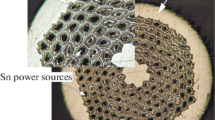Abstract
The residual resistivity ratio, R273/R20, is an important parameter for multifilament superconductors (strands) based on Nb3Sn that are used to manufature cables of magnetic systems. High values of RRR impart stability to the cable with regard to thermal excitations. Nb3Sn strands for magnetic system of the International Thermonuclear Experimental Reactor are manufactured from high purity oxygen-free copper with RRR > 250 units; however, after extended diffusion annealing intended to form superconducting phase Nb3Sn, the residual resistivity ratio values of the strands decrease. This work investigates the influence of diffusion annealing for 55–200 h during the final stage at 650°C on the residual resistivity ratio of chromium-plated Nb3Sn strands. The contents of chromium and oxygen have been analyzed using X-ray spectral microanalysis of the strand surface and peripheral copper layers. Mass spectrometry with inductively coupled plasma (ICP mass spectrometry) has been used to determine the total chromium content in the copper shell. The influence of chromium and oxygen diffusion from coating during annealing at 650°C on the residual resistivity ratio has been demonstrated. Based on the data of ICP mass spectrometry, the depth of the penetration of chromium in a copper shell has been assessed.
Similar content being viewed by others
References
V. A. Al’tov, V. B. Zenkevich, M. G. Kremlev, and V. V. Sychev, Stabilization of Superconducting Magnetic Systems (Izdat. Dom MEI, Moscow, 2008).
Technical Specification ANNEX B to Procurement Arrangement 1.1.P6A.RF.01.0.
R. Wesche, F. Roth, and P. Bruzzone, “Final Report on Tests of Advanced Nb3Sn Strand EFDA,” ref. ASTEST Contract 03-1121, Deliverable 4.5 (2006).
M. V. Polikarpova, N. I. Kozlenkova, A. D. Nikulin, A. K. Shikov, V. I. Pantsyrnyi, A. E. Vorob’eva, E. A. Dergunova, E. N. Popova, L. and A. Rodionova, “On the Relationship between the Microstructure and Electrical Resistivity of Copper Used in Superconducting Composites,” Phys. Met. Merallogr. 91, 137–144 (2001).
A. E. Vorobieva, A. D. Nikulin, A. K. Shikov, V. I. Pantsyrnyi, M. V. Polikarpova, N. I. Kozlenkova, E. A. Dergunova, E. N. Popova, and L. A. Rodionova, “The Experimental Investigation of Copper for Superconductors,” Physica C 354, 371–374 (2001).
M. D. Sumption and E. W. Collings, “Influence of Chromium Diffusion and Related Phenomena on the Resistance Ratios of Bar and Cr-Plated Nb3Sn Strands,” Proceedings of Workshop on the Effects of Chromium Coating on Nb 3 Sn Superconductor Strand (Proceedings CONF-9404128, Lawrence Livermore Natl. Lab., 1994).
A. Vorobieva, A. Shikov, V. Pantsyrnyi, E. Dergunova, A. Silaev, N. Beliakov, N. Kozlenkova, M. Polikarpova, K. Mareev, O. Malafeeva, and S. Kuznetsov, “The Study of Cu Fraction Influence on Nb3Sn Strand for ITER Performance,” IEEE Trans. Appl. Supercond. 10, 1004–1007 (2000).
J. Kim, K. Sim, K. Jang, S. Je, P. Park, and K. Kim, “Effects of Cr Diffusion in RRR Values of Cr-Plated Nb3Sn Strands Fabricated by Internal-Tin Process,” IEEE Trans. Appl. Supercond. 18, 1043–1047 (2008).
A. Pontau, “A Search for Chromium in Copper,” Proceedings ofWorkshop on the Effects of Chromium Coating on Nb 3 Sn Superconductor Strand (Proceedings CONF-9404128, Lawrence Livermore Natl. Lab., 1994).
M. C. Jewell, T. Boutboul, L.-R. Oberli, F. Liu, Y. Wu, A. Vostner, T. Isono, Y. Takahashi, S.-H. Park, A. Shikov, A. Vorobieva, N. Martovetsky, K. Seo, D. Bessette, and A. Devred, “World-Wide Benchmarking of ITER Nb3Sn Strand Test Facilities” IEEE Trans. Appl. Supercond. 20, 1500–1503 (2010).
Standard MEK 61788-11 IEC: 2003(E). Residual Resistance Ratio of Nb 3 Sn Composite Superconductors.
E. R. Gustav and E. R. Schulze, Metallophysik (Akademie-Verlag, Berlin, 1967; Mir, Moscow, 1971).
J. Linde, “An Experimental Study of the Resistivity-Concentration Dependence of Alloys,” Helv. Phys. Acta 41, 1007–1015 (1968).
R. N. Randall, “Quality Assurance Requirements, Proceedings of Industry Participation Workshop “Chromium Electroplating of Superconductor Strand” (December, 1994, Lawrence Livermore Natl. Lab., 1994), pp. 35–47; http://www.osti.gov/bridge/servlets/purl/52822-Qsr4J4/webviewable/52822.pdf.
Author information
Authors and Affiliations
Corresponding author
Additional information
Original Russian Text © D.S. Novosilova, I.M. Abdyukhanov, A.E. Vorob’eva, E.A. Dergunova, M.V. Polikarpova, K.A. Mareev, N.V. Traktirnikova, E.N. Popova, I.L. Deryagina, S.V. Sudareva, 2012, published in Fizika Metallov i Metallovedenie, 2012, Vol. 113, No. 10, pp. 1008–1013.
Rights and permissions
About this article
Cite this article
Novosilova, D.S., Abdyukhanov, I.M., Vorob’eva, A.E. et al. Influence of diffusion annealing on residual resistivity of Nb3Sn-based chromium-plated strands obtained by a bronze process. Phys. Metals Metallogr. 113, 957–962 (2012). https://doi.org/10.1134/S0031918X12100080
Received:
Accepted:
Published:
Issue Date:
DOI: https://doi.org/10.1134/S0031918X12100080




